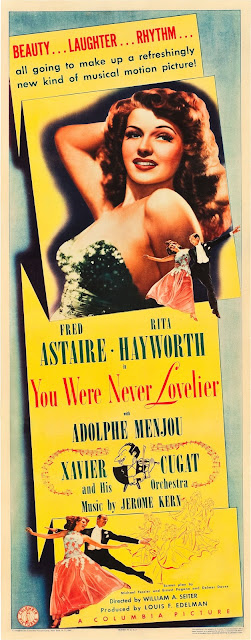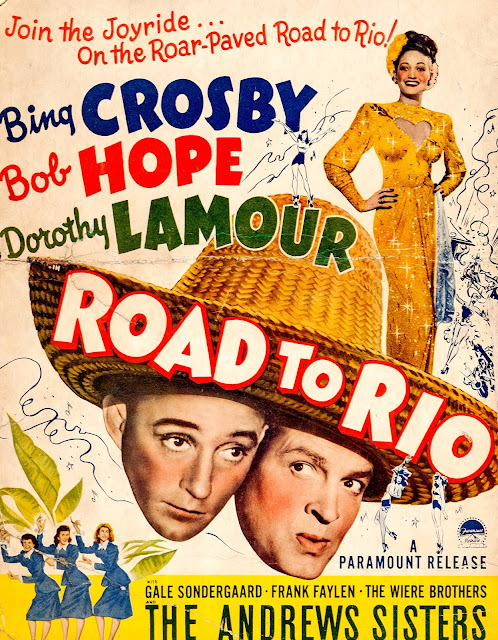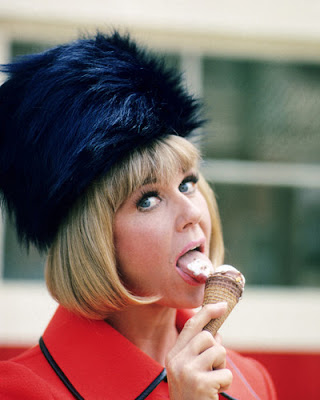An Ode to Sun Valley Serenade and its Star, Sonja Henie
Imagine this: after winning gold at the Olympics, an athlete like Michael Phelps or Chloe Kim goes to Hollywood, films a movie for six weeks, and then a few months later that movie is released and they become one of the biggest stars in the world. Seems crazy, right? However, this is precisely what happened to Norwegian figure skater Sonja Henie. In Hollywood's history, there have been plenty of athletes-turned-actors, but few rose to such dazzling heights as ice queen Henie, a woman who carved out her own unique genre and became one of the wealthiest people in the world.
Henie's determination and talent knew no bounds. She entered her first Olympics in 1924 at the incredible age of 11. When she was 14, she won her first of ten consecutive World Figure Skating Championships (a record that still stands) and she would soon rack up six European championships in a row. What may be most impressive about Henie's competitive career is that she won the gold medal three consecutive times at the 1928, 1932, and 1936 Olympic Games, a record for ladies' single skaters that still hasn't been matched. As if that wasn't enough, she is also credited with introducing short skirts and white skates to the sport, as well as the ballet and dance influences you see nowadays in the style and choreography of skaters. Sports Illustrated once wrote that Henie's glamour and innovation transformed her sport and helped legitimize its place at the Olympics. You can see footage of Henie performing at the 1932 games here and after the 1928 games here.
After the 1936 Olympics, 24-year-old Henie made a bold move. She retired from competitions at the top of her game and took her skates to Hollywood, telling The New York Times, "I want to do with skates what Fred Astaire is doing with dancing." Her expectations were simple: $75,000 per film ($1.3 million in 2018 money!) and the films must be built around her (no supporting roles or specialty numbers for this gal!). All of the studios balked and Henie swiftly proved that she was worth it by staging a live ice show that brought in $28,000 in just a few nights.
As you can guess, the studios changed their tune and Henie struck an amazing deal with 20th Century Fox. For her first film, One in a Million, she was paid $60,000; she then signed a five-year contract that gave her $125,000 per film, which is $2.2 million in today's money. As part of her contract, Henie would only film in the summer, allowing her to work in her live ice show in the winter.
Those ice shows, by the way, were Henie's brilliant way of staying in the public eye and keeping audiences interested in her movies. Funnily enough, she had to convince promoters to take a chance on her much like she had to with the movie studios. When her price of $10,000 per night was refused by promoters, she rented a rink in Pennsylvania for three nights and demonstrated that she could bring in people.
Henie's determination and talent knew no bounds. She entered her first Olympics in 1924 at the incredible age of 11. When she was 14, she won her first of ten consecutive World Figure Skating Championships (a record that still stands) and she would soon rack up six European championships in a row. What may be most impressive about Henie's competitive career is that she won the gold medal three consecutive times at the 1928, 1932, and 1936 Olympic Games, a record for ladies' single skaters that still hasn't been matched. As if that wasn't enough, she is also credited with introducing short skirts and white skates to the sport, as well as the ballet and dance influences you see nowadays in the style and choreography of skaters. Sports Illustrated once wrote that Henie's glamour and innovation transformed her sport and helped legitimize its place at the Olympics. You can see footage of Henie performing at the 1932 games here and after the 1928 games here.
After the 1936 Olympics, 24-year-old Henie made a bold move. She retired from competitions at the top of her game and took her skates to Hollywood, telling The New York Times, "I want to do with skates what Fred Astaire is doing with dancing." Her expectations were simple: $75,000 per film ($1.3 million in 2018 money!) and the films must be built around her (no supporting roles or specialty numbers for this gal!). All of the studios balked and Henie swiftly proved that she was worth it by staging a live ice show that brought in $28,000 in just a few nights.
As you can guess, the studios changed their tune and Henie struck an amazing deal with 20th Century Fox. For her first film, One in a Million, she was paid $60,000; she then signed a five-year contract that gave her $125,000 per film, which is $2.2 million in today's money. As part of her contract, Henie would only film in the summer, allowing her to work in her live ice show in the winter.
Those ice shows, by the way, were Henie's brilliant way of staying in the public eye and keeping audiences interested in her movies. Funnily enough, she had to convince promoters to take a chance on her much like she had to with the movie studios. When her price of $10,000 per night was refused by promoters, she rented a rink in Pennsylvania for three nights and demonstrated that she could bring in people.
Henie's time in Hollywood was brief, lasting only twelve films, her last being 1948's The Countess of Monte Cristo. During those twelve years, the skater had several lucrative endorsement contracts, with deals to market all sorts of merchandise with her name on it, including skates, jewelry, and dolls. Pretty soon, Henie found herself ridiculously wealthy. Her success was so incredible that it encouraged other studios to try and duplicate the formula. This is most evident in the stunning career of MGM’s "Million Dollar Mermaid" Esther Williams.
Actually, it was because of my Esther Williams obsession that I came to know about Henie. It took a few years for me to finally see her work, but when I did, I couldn't have picked a better introduction: 1941's Sun Valley Serenade. After recording the film from TCM and then just a few days later reading a fantastic review of it over at Silver Screenings, I felt like the universe was not-so-subtly nudging me towards watching this movie. Within the first two minutes, I was in love, and after a second viewing, I realized that it was going to be one of my favorite movies ever.
The story is fairly simple. Phil Corey (Glenn Miller) and his orchestra are stunned when they discover that the war orphan their pianist Ted (John Payne) adopted as a publicity stunt turns out to be the beautiful Norwegian Karen (Henie). Grateful for Ted's sponsorship, Karen quickly falls for him and wants to get married, but Ted is enamored with their band's vocalist, Vivian (Lynn Bari). When the band goes to Sun Valley, Idaho for a lucrative engagement, Ted tries to leave Karen behind in New York, but she convinces their publicist "Nifty" (Milton Berle) to sneak her on the train. Once in Sun Valley, Karen and Ted begin spending more time together -- which takes some crafty engineering on her part -- until finally Ted realizes Karen is the right woman for him.
This film combines so many of the things that I adore: Henie's skating, John Payne's singing, the Nicholas Brothers' dancing (with Dorothy Dandridge, Harold Nicholas's soon-to-be wife!), a charmingly daffy plot, and a tremendous score provided by Glenn Miller and His Orchestra. That score, by the way, includes the songs of Miller's that I cherish the most: Oscar-nominated "Chattanooga Choo Choo," "Moonlight Serenade," and "In the Mood." Sun Valley Serenade is also where the song "At Last" originated from. Written by Mack Gordon and Harry Warren specifically for the film, it was cut from the final product and saved for Glenn Miller's second (and final) movie, Orchestra Wives, but thankfully you can still hear instrumental pieces of the tune in a nightclub scene and in Henie's spectacular skating finale.
That finale, by the way, is the only flashy number in SVS and it is just the second time Henie skates, her other routine being much more informal with an almost improvisational feel. The finale is nothing short of magical. The use of the contrasting black and white mise-en-scene is exquisite, and the reflections of Henie and her chorus of skaters on the black ice create such a striking, elegant image. The camera doesn't stay static either, but instead glides right alongside Henie as if it were her partner.
Actually, it was because of my Esther Williams obsession that I came to know about Henie. It took a few years for me to finally see her work, but when I did, I couldn't have picked a better introduction: 1941's Sun Valley Serenade. After recording the film from TCM and then just a few days later reading a fantastic review of it over at Silver Screenings, I felt like the universe was not-so-subtly nudging me towards watching this movie. Within the first two minutes, I was in love, and after a second viewing, I realized that it was going to be one of my favorite movies ever.
The story is fairly simple. Phil Corey (Glenn Miller) and his orchestra are stunned when they discover that the war orphan their pianist Ted (John Payne) adopted as a publicity stunt turns out to be the beautiful Norwegian Karen (Henie). Grateful for Ted's sponsorship, Karen quickly falls for him and wants to get married, but Ted is enamored with their band's vocalist, Vivian (Lynn Bari). When the band goes to Sun Valley, Idaho for a lucrative engagement, Ted tries to leave Karen behind in New York, but she convinces their publicist "Nifty" (Milton Berle) to sneak her on the train. Once in Sun Valley, Karen and Ted begin spending more time together -- which takes some crafty engineering on her part -- until finally Ted realizes Karen is the right woman for him.
This film combines so many of the things that I adore: Henie's skating, John Payne's singing, the Nicholas Brothers' dancing (with Dorothy Dandridge, Harold Nicholas's soon-to-be wife!), a charmingly daffy plot, and a tremendous score provided by Glenn Miller and His Orchestra. That score, by the way, includes the songs of Miller's that I cherish the most: Oscar-nominated "Chattanooga Choo Choo," "Moonlight Serenade," and "In the Mood." Sun Valley Serenade is also where the song "At Last" originated from. Written by Mack Gordon and Harry Warren specifically for the film, it was cut from the final product and saved for Glenn Miller's second (and final) movie, Orchestra Wives, but thankfully you can still hear instrumental pieces of the tune in a nightclub scene and in Henie's spectacular skating finale.
That finale, by the way, is the only flashy number in SVS and it is just the second time Henie skates, her other routine being much more informal with an almost improvisational feel. The finale is nothing short of magical. The use of the contrasting black and white mise-en-scene is exquisite, and the reflections of Henie and her chorus of skaters on the black ice create such a striking, elegant image. The camera doesn't stay static either, but instead glides right alongside Henie as if it were her partner.
Although Henie influenced figure skating immensely, contemporary audiences might be surprised by how much her skating differs from what you'd see pros like Kristi Yamaguchi, Michelle Kwan, or Dorothy Hamill doing. Henie's routines don't consist of complicated combinations, dramatic hand and arm gestures, or elongated glides. Rather than do triple Salchows and toe loops, she sticks with running across the ice on her toes, quick leaps, and absurdly fast spins that abruptly end with pretty poses. It is fascinating to watch, partly because we'll never see skating like this again.
Henie's films are wholly hers — she is the center of attention; she is the reason why these movies exist. It is easy to scoff at these fluffy confections, but there are few movies today that can replicate the effortless, easygoing charm that these films and their star exuded. I also have to applaud Henie's confidence in herself and her abilities. She knew what she wanted and she fought for it, regardless of what others said. She created her own unique place in Olympic history, figure skating history, and, improbably, film history, all before the age of 25. I couldn't appreciate this woman's originality and fearlessness any more if I tried.
Henie's films are wholly hers — she is the center of attention; she is the reason why these movies exist. It is easy to scoff at these fluffy confections, but there are few movies today that can replicate the effortless, easygoing charm that these films and their star exuded. I also have to applaud Henie's confidence in herself and her abilities. She knew what she wanted and she fought for it, regardless of what others said. She created her own unique place in Olympic history, figure skating history, and, improbably, film history, all before the age of 25. I couldn't appreciate this woman's originality and fearlessness any more if I tried.
The crazy thing about SVS is that ever since I first saw it, it keeps popping into my life in unexpected ways. When I was studying abroad a few years ago, I was having lunch with another student and talking about why I enjoyed classic films when he suddenly said, "This is a really obscure one, but do you know Sun Valley Serenade? It was my grandmother's favorite movie." I almost fell out of my chair. That same feeling hit me again when I saw The Shape of Water (2017) in theaters and "I Know Why (and So Do You)" was used as the backdrop to a romantic montage. A more recent connection happened last year when my family was cleaning out my grandfather's house. I found this giant vinyl record compilation of Glenn Miller songs and I became downright giddy when I discovered that one whole record was the SVS soundtrack.
Frankly, it's kind of comforting that this movie seems to always be with me. In a way, it is indicative of how classic Hollywood has remained in pop culture and the public conscious, although it can feel like everyone would rather drool over the latest CGI nonsense than look at something as pure as Henie and Payne singing to each other in the glow of an isolated cabin's fireplace. It's also just nice to see that a little-known gem such as SVS can still be acknowledged and referenced almost 80 years after its release.
For me, SVS is what I call "cinematic comfort food," that type of irreplaceable film in your life that can cheer you up no matter what. Everything about it is cozy, from Glenn Miller's incomparable music to the snow-covered mountains to John Payne's reindeer sweater. Do yourself a big favor and check out the film here!
For me, SVS is what I call "cinematic comfort food," that type of irreplaceable film in your life that can cheer you up no matter what. Everything about it is cozy, from Glenn Miller's incomparable music to the snow-covered mountains to John Payne's reindeer sweater. Do yourself a big favor and check out the film here!
__________________
This is my entry to the Box Office Jocks Blogathon, hosted by Dubsism and Return to the 80's. Be sure to check out the other entries here!




















































I will admit I'm not terribly familiar with Sonja Henie, but this was an informative read, and I'm glad you contributed it to this blog-a-thon!
ReplyDeleteThank you! Henie has become somewhat of a forgotten figure, which is unfortunate, but I'm happy that you found my post engaging!
DeleteI love researching the film, 'Sun Valley Serenade'. I also enjoy researching and chronicling the music and career of Glenn Miller (1904-1944).
ReplyDeleteI happened to be flipping channels and came upon Sun Valley Serenade during the finale and I was stunned by black, mirror perfect ice. It is truly amazing how spectacular the ice looks and holds up during the skating considering this was filmed in 1941. Amazing that none of the black dye shows up on any of the costumes or skaters.
ReplyDeleteMy mother and I used to watch Sonia Henie skate when I was a little girl on all of her movies. She was one of our favorite stars to watch. Today would have been my mother's 94th birthday and they just showed this film tonight on TV. I am liking to think that it was a perfect birthday present for her. Such a sweet film.
ReplyDeleteThis is one of my favorite movies of all times. It's the all time most underrated gem. It's stacked. Besides Henies skating It's got the Glen Miller orchestra doing 3 major hits, including the first ever million selling record, Chatanoga Choo Choo. It's got the Nicolas Brothers in their prime. It's got a VERY young Milton Berle chewing up his scenes. This movie is awesome! FYI, it was filmed when the Sun Valley resort had only been open for a year. I watch it every year when I go to skate on the outdoor rink in Sun Valley!
ReplyDelete